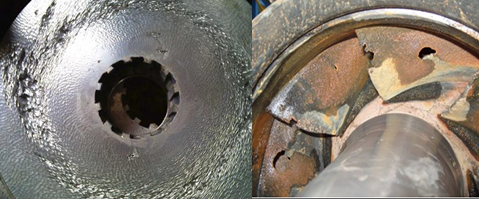When the pump is working, the liquid will produce vapors at the inlet of the impeller due to a certain vacuum pressure, and the vaporized bubbles will exfoliate the impeller and other metal surfaces under the impact movement of the liquid particles, thus destroying the impeller and other metals, at this time the vacuum pressure is called vaporization pressure, and the cavitation margin refers to the excess energy per unit weight of liquid at the inlet of the pump that exceeds the vaporization pressure, the unit is marked in meters and (NPSH) r. The suction distance is the necessary cavitation allowance Δ h: that is, the vacuum of the pump allowed to absorb liquid, that is, the allowable installation height of the pump, per meter. Suction distance = standard atmospheric pressure (10.33 meters)-cavitation margin-safety capacity (0.5 meters) standard atmospheric pressure pressure pipeline vacuum height 10.33 meters.

Methods to reduce cavitation margin:
a. Measures for increasing effective cavitation margin of liquid intake device.
The main results are as follows:
(1) increase the pressure of the liquid level in the liquid storage tank in front of the pump to increase the effective cavitation margin.
(2) reduce the installation height of the suction device pump.
(3) change the upper suction device into reverse irrigation device.
(4) reduce the flow loss on the pipeline in front of the pump. Such as shortening the pipeline as much as possible in the required range, reducing the flow rate in the pipeline, reducing bends and valves, increasing the valve opening as much as possible, and so on.
(5) reduce the temperature of the working medium at the inlet of the pump (when the conveying working medium is close to the saturation temperature).
The above measures can be comprehensively analyzed and applied appropriately according to the conditions of pump type selection, material selection and pump use site.
b. Measures to improve cavitation resistance of pump itself.
The main results are as follows:
(1) improve the structural design of the suction inlet of the pump near the impeller. Increase the over-flow area; increase the radius of curvature of the inlet section of the impeller cover to reduce the sharp acceleration and depressurization of the liquid flow; appropriately reduce the thickness of the blade inlet and round the blade inlet to make it close to streamline, it can also reduce the acceleration and pressure reduction around the head of the flow blade, and improve the surface finish of the impeller and blade inlet to reduce the resistance loss. Extend the blade inlet edge to the impeller inlet to make the liquid flow accept the work in advance and increase the pressure.
(2) the front inducer is used to make the liquid flow work ahead of time in order to increase the liquid flow pressure.
(3) in the design condition, a slightly larger positive impact angle is adopted to increase the inlet angle of the blade, reduce the bending at the entrance of the blade, reduce the blockage of the blade, increase the inlet area, and improve the working conditions under large flow to reduce the flow loss. But the positive attack angle should not be too large, otherwise it will affect the efficiency.
(4) adopt anti-cavitation materials. The practice shows that the higher the strength, hardness and toughness of the material, the better the chemical stability and the stronger the cavitation resistance.
TEFLOW PUMPS so IHF impellers are made of fluoroplastic alloy sintered, with good strength, hardness, toughness, so strong anti-cavitation effect.





 +86 18130251359
+86 18130251359 teflowpumps@tlpumps.com
teflowpumps@tlpumps.com








 +86+0563-5093318
+86+0563-5093318
